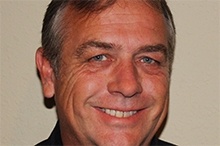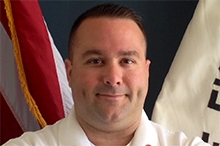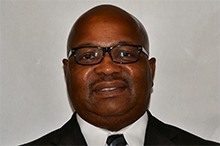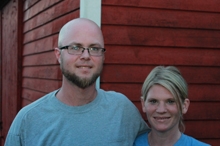Champions of Change Blog
Passion for Public Safety
Posted by on September 15, 2014 at 4:18 PM EST
Phil Amtower is being honored as a Individual and Community Preparedness Champion of Change.
I have been involved in public safety for over 20 years. For the past 16 years, I have worked in the field of emergency management. I started out as a volunteer firefighter, and my passion for public safety grew from there.
In 1997, I was appointed by the county commission as Emergency Management Director. This was basically a volunteer position; I received $100 a month of pay and had a budget of merely $5,000 per year. I continued my emergency management work in this capacity until 2003, when I convinced the county commission that this position needed to be a full-time job. After 3 months as a full-time employee, we had our first major emergency. An F-3 tornado made its way through the western part of our county and left a wide path of destruction.
The next day, I was incredibly overwhelmed. There was a whole lot of work to do, and I was only one person! I decided that we needed more members of our community involved in emergency preparedness and management, so I decided to start a Community Emergency Response Team (CERT). I took the train-the-trainer course and taught my first class to our first group of volunteers in October 2003.
Since then, we have taught 53 classes and trained over 1,000 people in our county alone. The main goal of CERT is to train people to be better prepared for disasters and to empower them to help themselves and others in the wake of a disaster. After completing the course, the students can sign up as CERT volunteers. Right now, we have over 200 CERT volunteers in our county, and they provide over 4,000 service hours annually. This incredible team has been instrumental in preparing our communities for disasters before they strike.
Later, it became clear to me that we needed to work with other CERT volunteers across the state to address crises when they occur. In May 2011, an F-5 tornado hit southwest Missouri and devastated the city of Joplin. While thousands of CERT volunteers across Missouri responded, each CERT group responded in a different way. That uncoordinated approach hurt our emergency response efforts. After that, I decided that we needed a unified approach that would alleviate some of the duplication that happened in Joplin and harness all the resources from southwest Missouri’s CERT groups. When all of the groups next met, I pitched the idea, and MO CERT 1 was born. So far, the MO CERT 1 team has been deployed all across the Midwest, from Moore, Oklahoma, to Baxter Springs, Kansas, to Branson, Missouri. The team can provide shelter support, perform wilderness search and rescue, remove debris, and conduct damage assessments and wellness checks.
My experiences have shown me that we can only respond effectively to emergencies if we come together and rely on each other. It’s been incredibly meaningful to help make that happen in my home state of Missouri.
Phil Amtower is the Director of Emergency Management for Christian County, Missouri and the Task Force Leader for MO CERT 1.
Learn more aboutChanging the Culture through Education and Understanding
Posted by on September 15, 2014 at 4:12 PM EST
Lt. Brian K. Rand is being honored as a Individual and Community Preparedness Champion of Change.
As an emergency responder, I’ve been taught that all events have a “life cycle.” They consist of a beginning, a middle, and an end. But emergency management and community preparedness do not have a life cycle. They have a beginning, but the task of managing emergencies and preparing our communities is unending.
That’s what I find so exciting about emergency preparedness. Preparedness means getting ready for an event before it happens, even if such an event has never occurred in a given community. I am happy to say that this approach is now guiding emergency services preparedness and training across the country.
Preparing emergency action plans for an event that may or may not occur can be a daunting task; it always requires a great amount of time, effort, research, and training. I have found that it is important to remember two things throughout this difficult process. First, always ask “what if.” And second, never place yourself in the position of having to answer the question of “what do we do now.” Changing the culture of emergency response to be proactive is a major goal we should all strive to achieve.
My work at the Watertown Fire Department has given me a chance to enact my vision of proactive community preparedness. As an example, we have worked with stakeholders to enact policies to deal with opioid overdoses and the pre-hospital treatment of these events. The Department went to great lengths to meet with community activists, hospital officials, and medical directors, as well as to enhance our pre-hospital treatment of overdoses on scene during the event.
Because we saw great success with this program, we are now working with local partners to help change the legislation to have the same medication we provide also available on scene (Naloxone). By educating and changing the culture of how communities perceive an individual who becomes addicted, we gain greater support for important programs that help treat individuals with addictions. The Department offers training to families to help better understand addiction and to save the life of a family member in an emergency. At a minimum, we hope that our education and training will allow an individual who cares for a person afflicted with addiction to have the proper tools to save his or her life.
A piece of advice that I received as a U.S. Marine from my Gunnery Sergeant, Kenneth Crutcher, still guides my thinking today: “If you find yourself with nothing more to do, you are wrong.” This is the mindset you must maintain while creating and implementing emergency preparedness plans of all shapes and sizes. You are never done. You can always go back and make things better.
This is the attitude that ensures emergency preparedness workers build relationships with community members who are needed to create community-centered solutions to emergencies. Engaging these local partner is vital because they will be the ones there in the event of an emergency. Preparing all aspects of a community is the key to success in an ever-changing emergency management landscape here in the United States.
Lt. Brian K. Rand serves as the Emergency Medical Services Coordinator and Training Officer for the Watertown, Massachusetts Fire Department.
Learn more aboutPutting Others before Yourself
Posted by on September 15, 2014 at 4:02 PM EST
Marny D. McLee, Sr. is being honored as a Individual and Community Preparedness Champion of Change.
I have always had a strong commitment to my family, community, and country. I grew up in a single-parent household and was the oldest of six boys, so I had to step up and help take care of my family. This showed me that I could dedicate myself to improving the lives of those around me—members of my family, community, and country. When I was old enough, I joined the military and served on Active Duty in the U.S. Air Force for over 20 years. The values I learned from my experiences with my family and in the military are now a part of me, and those values have driven me towards working in community preparedness.
My journey to Citizen Corps started over 10 years ago, when I began a second career as an Emergency Planner. In this role, I presented to community groups, faith-based groups, and schools about Citizen Corps and the importance of emergency preparedness. Engaging with these communities showed me that my true calling was in family safety and community preparedness.
Early on, it was clear to me that partnerships and outreach had to be two pillars of our community preparedness work in Delaware. To bring together local stakeholders and ensure community investment, we made it mandatory for programs to be sponsored by a county or local emergency manager, fire chief, or chief of police. We also discovered that the business community, educational institutions, and non-profits could be helpful in providing citizens with opportunities to get involved in community preparedness. We now have partnerships with organizations all across the state, such as the Boy Scouts of America and the YMCA. We also have strong relationships with faith-based communities, such as the Muslim community.
I’ve learned that partnerships allow us to do much more than we could ever do alone. For example, we sponsor an annual Family Emergency Preparedness Day, and it is absolutely essential that we have help from our partners. Working with Minor League Baseball has allowed us to spread our preparedness message all season long. We have also built a partnership with the amateur radio community, which helps us effectively improve emergency communications during times of disaster.
I have also helped establish local groups of emergency preparedness volunteers so that communities all across the state are prepared for emergencies. I have pushed the State Citizen Corps Council to establish local citizen corps councils and provide them with support as they engage their own communities. By empowering local communities, we have been able to create solutions tailored to the unique needs of diverse communities.
Providing people with the chance to serve through volunteer opportunities is important to bringing together communities. Through educating and training volunteers, we reach even more people in need of community preparedness. And by providing opportunities for volunteers to contribute, we ensure that communities are actively involved and empowered in the process of preparing for emergencies.
Our strategy of partnerships and outreach has helped us reach more people than I ever could have imagined. I am incredibly proud of the work we have done to prepare the citizens of Delaware for disasters.
Marny D. McLee, Sr. is the Delaware Citizen Corps and Community Emergency Response Team (CERT) Training and Outreach Coordinator. He works at the Delaware Emergency Management Agency (DEMA).
Learn more aboutVeteran Entrepreneurs Honored as White House Champions of Change
Posted by on September 4, 2014 at 1:36 PM ESTEd. note: This is cross-posted on the Small Business Administration's blog. See the original post here.
The energy in the room was inspiring as 11 veteran and veteran spouse entrepreneurs took the stage to be honored as Champions of Change on August 27. Invited to the White House to be honored for their extraordinary achievements, these “Champions” are community leaders who empower veterans and give back to the veteran community.
Throughout the event, there was one constant theme: Veterans are natural leaders. Military training provides veterans with a skillset that translates directly to entrepreneurship. “People might learn leadership in various ways, but there’s no place like the military,” said Champion Louisa Long Jaffe, who attributes the problem-solving skills taught in the military as one of many reasons veterans not only make successful entrepreneurs but also great employees.
The Champions also spoke of their passion to serve; a passion that has evolved from serving their country in uniform, to serving their communities by creating jobs, providing solutions, and contributing to economic growth.
Learn more aboutNominate a White House Champion of Change for Disability Employment
Posted by on September 2, 2014 at 2:09 PM ESTPeople with disabilities, including significant disabilities, have the skills and talent to make meaningful contributions within America’s workplaces. Advancing employment opportunities and expectations for people with disabilities strengthens not only our economy, but also our society. It creates a more inclusive America where people with disabilities benefit from the intrinsic value of work and develop pride in knowing that they too play a role in the growth and success of our Nation. This Administration has worked steadfastly to address the persistent barriers to employment for people with disabilities and shift the conversation about disability employment from one focused on whether people with disabilities can work, to one more aptly focused on what we can do to ensure that people with disabilities are given the chance to succeed in our nation’s workforce and lift themselves into the middle class and beyond.
While the President will continue to do everything he can to increase the employment rates of people with disabilities, we know efforts to spur hiring at the state and local levels – by small business owners, large companies, philanthropic organizations and self-employed entrepreneurs often have the most impact. The leaders who are creating change know that people with disabilities are an important part of the American workforce. Every day, these individuals are stepping up in big ways in our communities to make sure that all Americans with disabilities have equal opportunities and a pathway to the middle class.
Today, we’re asking you to help us identify and honor innovators who are breaking down barriers to the middle class by providing employment opportunities for workers with disabilities, including workers with significant disabilities. These extraordinary leaders will be invited to the White House to celebrate their accomplishments and showcase their actions to ensure that individuals with significant disabilities have a fair shot at succeeding in good jobs and careers. Please nominate a Champion of Change by midnight on Sunday, September 14, 2014. We are seeking Champions who reflect the diversity of our nation, including diversity of types/visibility of disabilities and veterans with disabilities. Nominees may include the following types of individuals:
- Small business owners who have lead efforts to hire workers with disabilities, including workers with significant disabilities, and who have hired and retained one or more workers with significant disabilities and a worker(s) who are helping to build that business while gaining middle class security.
- Managers within large or medium sized employers who have developed effective initiatives for the hiring, retention and/or promotion of people with disabilities, including workers with significant disabilities.
- Entrepreneurs with significant disabilities who have established successful businesses and are now employing others in a successful venture.
- Leader within companies or organizations who have disclosed hidden disabilities and have initiated efforts to educate others about employment of people with disabilities.
- Public/private partnerships between employers and a state or local governments, colleges, foundations, or other entities that have developed effective collaborative initiatives focused on increasing competitive integrated employment for people with disabilities, including people with significant disabilities.
Click on the link below to submit your nomination (be sure to choose Disability Employment in the "Theme of Service" field of the nomination form).
Nominate a Disability Employment Champion of Change
We are looking forward to hosting this event and to highlighting the great work communities across the country are doing to advance the employment of people with disabilities
Taryn Williams is an Associate Director in the Office of Public Engagement.
Learn more about DisabilitiesGrowing a Legacy
Posted by on August 4, 2014 at 3:55 PM EST
Ryan and Tiffany Batalden are being honored as a Future of American Agriculture Champions of Change.
It is an honor for us to be selected White House Future of American Agriculture Champions of Change. It is particularly appropriate that the White House is recognizing people out in the countryside who are thinking long and hard about the "future of American agriculture." There are many of us who see great opportunities in agriculture, but also recognize some of the significant barriers beginning farmers face if they are to get established successfully on the land.
Overcoming these barriers will require recognition on the part of all of us that diverse family farms play a key role in the economic, environmental and even social health of our communities. On our farm here in Southwestern Minnesota, we constantly ask the question, "What will be your farm’s legacy?" We often think of our legacy as related to our farm's financial success. Our legacy will show how we were able to weather hard times -- floods, droughts, bad weather, low prices, pests, weeds, changes in production methods, and other enormous challenges. Our legacy will show that not only did our farm survive, it prospered. Maybe it even grew in numbers of acres or livestock.
These are all important parts of our legacies. But what is our legacy in relation to our community? What is our legacy in relation to all of those pieces of our community that make it the place we love, and make it what it is? What is the legacy we leave for those who wish to move to or live in our area? What is the legacy we want to leave for the next generation of farmers?
We were able to farm for two simple reasons. Reason number one: our family supported us. However, the family farm was not big enough to support two families, so we had to find land to rent. And so the other reason we were able to farm was because of three landowners who valued helping a young farmer as much as they valued getting "top dollar." In return, we have treated their land with the care and respect we would as if we owned it. Because of this, and because we raise crops for specialty markets, these landowners have been rewarded financially as well.
This is just one small example of landowners letting their values guide their decision making, and benefitting a beginning farm family in the process. When land changes hands, is it done in a way that reflects a community's values? Without creative transition solutions, where will the next generation of farmers worship, shop, and send their kids to school? Will your neighbor's farm become a home for a new family of entrepreneurs, or simply one more field to till for a larger operation in the area? What are some ways we can show our values and ensure our legacy -- not just financially, but also in other ways -- when we transition our farm to the next generation?
Such questions can be hard to answer. However, as groups like the Land Stewardship Project have been able to show, there is a growing number of creative ways that retiring farmers have found to transition their land in ways that ensure that their farm's financial, family, and community legacy is preserved. If we look hard enough, we can all find ways to ensure our legacies in ways that truly reflect our values.
Ryan and Tiffany Batalden are fifth generation beginning farmers in Cottonwood County, Minnesota. Ryan serves on the Land Stewardship Project's Land Access Committee.
- &lsaquo previous
- …
- 16
- 17
- 18
- 19
- 20
- 21
- 22
- 23
- 24
- …
- next &rsaquo

